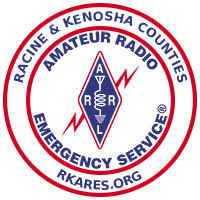During an emergency, when is ARES activated? How about RACES?
ARES is activated before, during and after an emergency. Generally, ARES handles all emergency messages, including those between government emergency management officials. RACES, on the other hand, almost never starts before an emergency and is active only during the emergency and during the immediate aftermath if government emergency management offices need communications support. RACES is normally shut down shortly after the emergency has cleared.
I don’t see ARES mentioned in Part 97? What’s the story?
True, there’s nothing in Part 97 about ARES specifically. ARES operators are, of course, bound by all applicable Part 97 rules, but they aren’t bound by the specific emergency rules as specified in §97.407, as stations operating under RACES are. ARES operators have greater flexibility. RACES stations are limited by Part 97 as to who they can communicate with, which messages they may pass, and how long drills may last.
Can any licensed amateur volunteer for RACES? How about ARES?
Yes on both counts. You can volunteer for RACES by enrolling with a civil defense organization locally. To volunteer for ARES, register with your local ARRL Emergency Coordinator.
I’ve heard that the FCC has in the past issued RACES licenses that can be used only for RACES activities. What’s the status of RACES licenses?
There are fewer than 250 RACES station licenses and calls have been issued from the WC#$$$ call sign block such as WC1AAA. They’ve been assigned to certain civil defense organizations, not to individual amateurs. The FCC stopped issuing new RACES licenses in 1978, and it will not renew existing ones. The FCC will not issue WC#$$$ calls under the Vanity program.
If I am enrolled in a local civil defense organization and if it declares a RACES drill, what call sign do I use since the FCC isn’t issuing RACES licenses? How about ARES?
RACES operation is conducted by amateurs using their own primary license call sign and by existing RACES licensees who hold RACES licenses. Club and military recreation stations are also eligible if authorized by a civil defense organization locally with the appropriate control operator [97.407(a)]. If you are operating under ARES, you can also use your own primary license and call sign or any other call sign authorized by a given control operator.
Which stations may a RACES station communicate with? How about ARES stations?
A station operating under RACES may only communicate with: 1) A RACES station licensed to the local civil defense organization; 2) Other RACES licensees; 3) Certain amateur stations registered with civil defense organizations; 4) Certain US government stations authorized by the responsible agency to communicate with RACES stations and; 5) Stations in a service regulated by the FCC when authorized by the FCC [97.407(d)]. A station operating in ARES may communicate with any amateur station.
What type of communications may be transmitted by stations operating under RACES?
RACES members may transmit only messages related to: 1) Impending danger to the public or affecting national defense during emergencies; 2) The immediate safety of individuals, the immediate protection of property, maintenance of law and order, alleviation of human suffering and need, and combating armed attack and sabotage; 3) The dissemination of information to the public from a local civil defense organization or other government or relief organization and; 4) Communications during RACES drills [97.407(e)].
How long may RACES drills and tests be held? What about ARES?
Panel TextRACES drills and tests can’t exceed a total time of one hour per week. With proper authorization, such drills and tests may be conducted for a period not to exceed 72 hours and such drills can occur no more than twice in a calendar year [97.407(e)]. There are no specific limits on ARES drills and tests.
Why are there limits on RACES drills?
These rules aren’t there to restrict amateurs unduly, but to protect the Amateur Radio Service from nonamateur abusers. The drill time limits were implemented in 1976 because, among other things, local government land mobile communications operators were using the amateur service improperly.
Our weekly RACES net is in operation for more than an hour per week. How can we be in compliance with §97.407(e) and still practice our emergency preparedness skills?
The easiest way is to make your RACES net an ARES net with the approval of your local EC so that your group isn’t bound by the specific time constraints, yet volunteers still get emergency preparedness training. If participating amateurs are registered in ARES and RACES, they can switch hats as conditions dictate. ARRL and FEMA both recommend dual membership. Stations operating under ARES have much more flexibility because the main purpose of ARES is to serve the emergency communications needs of many agencies, not just the government. RACES is structured and rigid and must be activated by a local civil defense official; ARES can be activated by an ARRL official such as the local ARRL Emergency Coordinator (EC).
How can I register for RACES? How about ARES?
RACES and ARES are both vital organizations and need your participation to make them effective. To register for RACES, contact your local civil defense office or Emergency Operations Center. To register with ARES, complete ARRL Form FSD-98 and send it to your local EC. If you don’t know who your EC is, contact your ARRL Section Manager.
